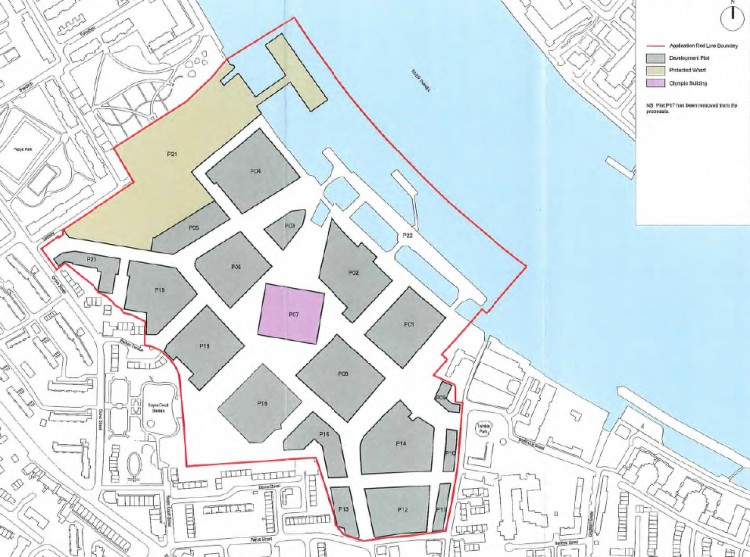In a few weeks’ time, the GLA will invite bids from independent assessors to carry out a study to determine the most feasible location on the Convoys Wharf site for the Lenox Project. This study forms part of the provision made by the Mayor of London for the Lenox Project as part of his decision to approve the planning application.
The full details of the invitation to pitch can be found in Annex 4 of the Section 106 agreement (starting on page 163) but the main points are outlined below.
The fee for the study is £20,000; this is being contributed by developer Hutchison Whampoa as negotiated by the GLA.
The assessor is only required to consider two potential locations on the site; the Olympia Building (pink on the map) and the Safeguarded Wharf (beige).
Our request that the assessor should be allowed to consider other potential locations was rejected by the Mayor last year.
The brief states that the Lenox Project requires a weatherproof area for shipbuilding of a minimum 52m long and 22m wide; it must be 16.5m high with additional clearance for a gantry crane. The project also requires space for storage, workshops and a visitor centre, and public access to these spaces is crucial for revenues.
The assessor is also only required to consider two scenarios for each potential location.
Olympia Building scenario 1: main shipbuilding in half of the Olympia Building, with waterway access required to the Thames for launch. Occupation of half the building at market rent for cultural use for a minimum term of 10 years and up to a maximum of 20, if a greater term is required to secure funding. Option for a subsequent lease at market rent by mutual agreement.
Olympia Building scenario 2: main shipbuilding in half of the Olympia Building, with waterway access required to the Thames for launch. Occupation of half the building at peppercorn rent for a minimum term of 10 years and up to a maximum of 20, if a greater term is required to secure funding, provided that any period over the initial 10 years is at market rent for cultural use. Option for a subsequent lease at market rent by mutual agreement.
Safeguarded Wharf scenario 1: main shipbuilding on 3,975sqm of safeguarded wharf with waterway access to the Thames for launch. Occupation of the safeguarded wharf at a peppercorn rent for a minimum term of 10 years and up to a maximum of 20, if a greater term is required to secure funding, provided that any period over the initial 10 years is at market rent for cultural use. No option for a subsequent lease due to existing wharf policy requirements.
Safeguarded Wharf scenario 2: main shipbuilding on 3,975sqm of safeguarded wharf with waterway access to the Thames for launch and the applicant making a contribution to the cost of waterway access. Occupation of the safeguarded wharf at a peppercorn rent for a minimum term of 10 years and up to a maximum of 20, if a greater term is required to secure funding, provided that any period over the initial 10 years is at market rent for cultural use. Option for a subsequent lease at market rent by mutual agreement, if there is a change in wharf policy requirements or the safeguarded wharf is de-designated.
The assessor will be asked to rank the four options in terms of their feasibility for delivering the Lenox Project, considering the influences of a number of factors. These include project delivery (extent of enabling works required, practicality of accommodating the project, and of delivering materials, compatibility with the site master plan, practicality of launch and of securing a permanent berth); project viability (costs for enabling works, ship building, future maintenance and potential for visitor attraction); heritage impact; environmental impact and impact on the approved Convoys Wharf master plan.
Once an assessor is chosen, they will have six weeks in which to carry out the research and write a draft feasibility report, after which it will be circulated for review by ourselves and Hutchison Whampoa.
A final report will then be produced by the assessor, having regard to any comments made in the review process.
Assuming that the feasibility study proceeds to the GLA’s proposed timeline, the final report should be published towards the end of July.

